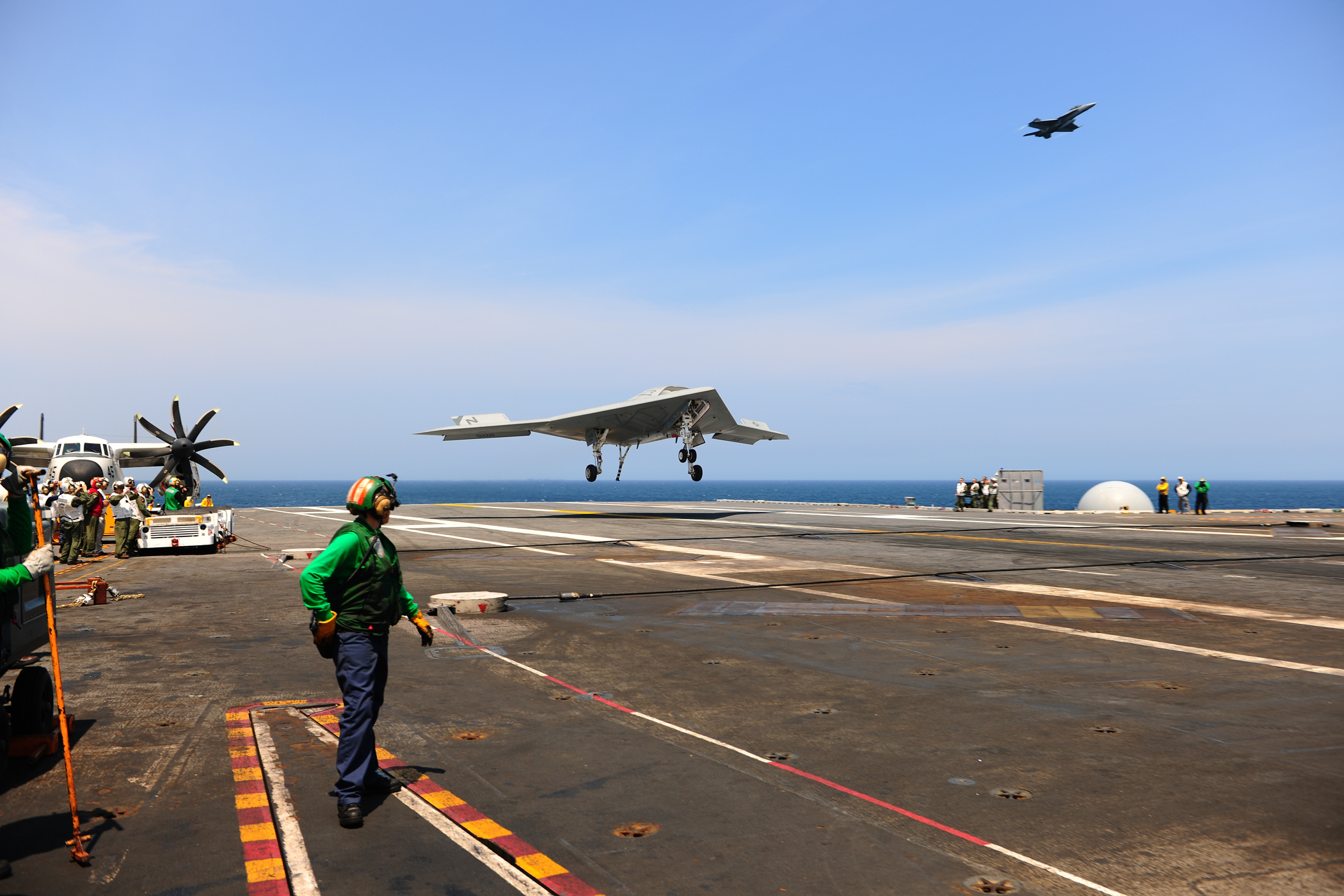The Navy’s First Carrier-Launched Drone Will Be a Flying Gas Tank

Credit to Author: David Axe| Date: Thu, 12 Oct 2017 17:00:00 +0000
Militaries all over the world together operate thousands of drones. Some big, some small. Some carrying missiles and bombs. Others equipped solely for surveillance.
But they have one thing in common: they’re land-based. With the exception of a few ship-compatible robot helicopters and small, hand- or catapult-launched drones, the world’s navies do not deploy sophisticated pilotless warplanes from their warships.
Most notably, there are no large, fixed-wing drones flying from the world’s roughly three dozen aircraft carriers. Carrier decks are complex, dangerous places. And for that reason, the drone revolution hasn’t yet made it to sea.
That’s about to change. The US Navy recently asked four American drone-makers— Boeing, Lockheed Martin, Northrop Grumman, and General Atomics—to pitch designs for what would be the world’s first combat-ready, carrier-launched unmanned warplane.
But there’s a catch. The new MQ-25, which the Navy hopes to put on carrier decks in the early 2020s, could start out flying one of the dullest, most routine missions in all of carrier aviation: acting as an aerial refueling tanker for other planes.
In other words, a flying gas tank.
At the same time, the Navy and industry are already looking ahead to the day when carrier-launched drones will carry missiles and bombs and begin replacing today’s manned warplanes on ships’ decks for even the most dangerous missions.
The Navy asked the four companies to submit designs for the jet-powered MQ-25 before September 2018, after which point the sailing branch plans to pick one model for further development and production.
The MQ-25 will be highly autonomous. Human operators aboard the carrier will be able to direct the drone via radio and satellite. On deck, the crew will remotely guide the aircraft around planes and people using a handheld controller.
Industry had been expecting the formal request for proposals. All four companies had already begun work on their respective versions of the MQ-25. Northrop Grumman brushed off the X-47B flying-wing drone that the Navy had used for initial carrier tests starting in 2012. General Atomics produced a bigger, more robust version of its Avenger drone, itself an evolution of the iconic Predator.
Lockheed Martin and Boeing also both possess drone prototypes that could form the basis for the MQ-25. All of the designs are compatible with a set of underwing fuel pods that’s already in Navy service. To refuel another plane, an aerial tanker reels out a hose from a pod. The pilot of the “thirsty” aircraft maneuvers a probe into a basket at the end of the hose and “drinks” fuel.
Aerial refueling helps to extend the range of the Navy’s manned fighters. Today an F/A-18, occasionally take fuel from other, pod-equipped F/A-18s, can fly around 450 miles with a useful load of weapons. That forces a carrier to sail within range of coastal anti-ship defenses before it can launch a strike.
The Navy wants to be able to hit targets from much farther away. To do so, it needs a plane that can fly right up to the edge of enemy defenses and loiter, waiting to pass extra fuel to manned fighters on their way to or from a bombing mission.
A high-endurance drone that doesn’t have to devote space to a human pilot seemed, to the Navy, to be a perfect fit. “The MQ-25 will give us the ability to extend the air wing out probably 300 or 400 miles beyond where we typically go,” Vice Admiral Mike Shoemaker wrote in Proceedings, the Navy’s semi-official trade magazine.
But the sailing branch didn’t always want its first carrier drone to be a mere tanker. In the early 2000s, the Navy and the Air Force worked together on an unmanned attack plane. When the Air Force dropped out of the program, the Navy downgraded the program to an experiment. Northrop Grumman built the X-47Bs for that initiative, which culminated in 2013 with the first successful landings and launches of a large drone from an aircraft carrier.
Encouraged by the experiment, the Navy moved quickly to develop a new, operational, carrier-launched drone. Then-Navy undersecretary Bob Work pushed for a high-tech, armed unmanned fighter. More skeptical planners in the Navy and Defense Department preferred to make the drone a tanker first, and then add weapons and sensors later.
Congress sided with Work, and as recently as this summer warned the Navy that it “may be unnecessarily excluding a critical capability.” But the skeptics won out. The MQ-25 will only be a tanker when it first enters service.
Not for long, though. The Navy reportedly told industry to save space inside their designs for a radar, an critical first step toward adding the sensors and weapons that the MQ-25 will need to eventually begin replacing the F/A-18s.
As Terry Kraft, a retired admiral who now works for General Atomics, told US Naval Institute News, “You can see a future for weaponization.”
Get six of our favorite Motherboard stories every day by signing up for our newsletter.